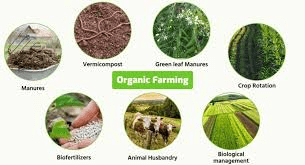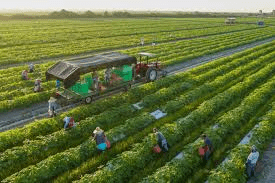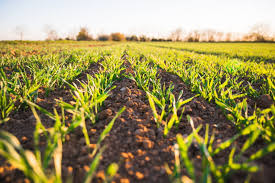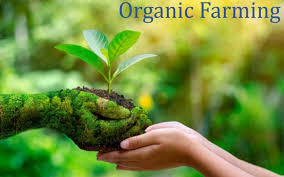Organic farming is a method of agriculture that relies on natural processes and inputs, avoiding synthetic chemicals and genetically modified organisms (GMOs). It emphasizes sustainable practices that promote ecological balance, biodiversity, and soil health. This farming approach nurtures the land, water, and air, fostering a harmonious relationship between nature and agriculture.
The foundation of organic farming lies in maintaining and improving soil fertility. Farmers achieve this by using natural fertilizers such as compost, manure, and green manure.
These organic materials enrich the soil with essential nutrients, improve its structure, and enhance its ability to retain moisture. Crop rotation and intercropping are also vital practices in organic farming. These techniques involve growing different crops in succession or simultaneously on the same land, reducing pest and disease cycles, and enhancing soil health.
Pest and weed management in organic farming are achieved through natural methods. Farmers use biological control, such as introducing beneficial insects that prey on pests, and mechanical control, like hand-weeding or mulching, to suppress weeds.
Additionally, crop diversity and rotation help minimize pest outbreaks. Organic farmers avoid synthetic pesticides and herbicides, opting instead for natural alternatives like neem oil, soap-based insecticides, and certain plant extracts.
Animal husbandry in organic farming follows ethical and sustainable principles. Livestock are raised in environments that allow natural behaviors and provide ample space for movement. Organic farmers prioritize animal welfare, ensuring access to organic feed, clean water, and outdoor grazing. Antibiotics and growth hormones are strictly avoided; instead, natural remedies and preventive measures are used to maintain animal health.
Water management is another crucial aspect of organic farming. Efficient irrigation systems, rainwater harvesting, and soil moisture conservation techniques help optimize water use. Organic farmers prioritize the protection of water resources by minimizing runoff and preventing contamination from agricultural activities.
Biodiversity is a key component of organic farming. By maintaining a variety of crops and livestock, organic farms create resilient ecosystems that can better withstand environmental stresses. This diversity also contributes to food security by providing a range of nutritious produce.
Organic farmers often incorporate agroforestry practices, integrating trees and shrubs into their farming systems. These practices enhance biodiversity, improve soil health, and provide additional income sources through the sale of timber, fruits, and other tree products.
The benefits of organic farming extend beyond the farm itself. Organic produce is free from synthetic pesticides and GMOs, offering consumers healthier and more nutritious food options.
Additionally, organic farming practices help mitigate climate change by sequestering carbon in the soil and reducing greenhouse gas emissions. The avoidance of synthetic fertilizers and pesticides also prevents soil and water pollution, protecting the environment and human health.
However, organic farming does face challenges. It can be labor-intensive and may require more knowledge and skills compared to conventional farming. Organic yields may be lower initially, and the transition period can be challenging for farmers. Despite these hurdles, the demand for organic products continues to grow, driven by increasing consumer awareness and preference for sustainable and healthy food options.
Organic farming is a holistic approach to agriculture that emphasizes sustainability, biodiversity, and natural processes. By fostering healthy soil, water, and ecosystems, organic farming contributes to a more sustainable and resilient food system. Its benefits extend to farmers, consumers, and the environment, making it a vital component of the future of agriculture.
Principles of Organic Farming

1. Soil Management: Healthy soil is the foundation of organic farming. Techniques like crop rotation, green manures, composting, and minimal tillage improve soil fertility and structure.
2. Crop Diversity: Organic farms often grow a variety of crops to enhance biodiversity, reduce pest and disease risk, and improve soil health.
3. Pest and Weed Control: Organic farming uses natural pest predators, crop rotations, and organic-approved pesticides like neem oil to manage pests. Weeds are controlled through mulching, hand weeding, and crop rotation.
4. Animal Welfare: Organic livestock farming ensures animals have access to outdoor spaces, organic feed, and are raised in conditions that allow for natural behaviors.
5. Sustainability: Organic farming aims to minimize environmental impact by reducing pollution, conserving water, and using renewable resources.
Steps to Start an Organic Farm
1. Soil Testing: Assess soil health and fertility. Conduct tests to determine pH, nutrient levels, and soil texture.
2. Choosing Crops and Livestock: Select crops and livestock suited to your climate, soil, and market demand.
3. Certification: Obtain organic certification from a recognized body. This process involves adhering to organic standards and regular inspections.
4. Crop Planning: Develop a crop rotation plan to maintain soil health and manage pests and diseases.
5. Composting: Start composting to create organic fertilizer for your crops.
6. Natural Pest Control: Implement integrated pest management (IPM) practices to control pests without synthetic chemicals.
7. Marketing: Develop a marketing strategy to sell your organic produce. Options include farmers’ markets, CSA programs, and online sales.
Read Also: Types of Wild Dogs and their Characteristics
Benefits of Organic Farming

1. Environmental Health: Organic farming practices enhance soil health and biodiversity. By avoiding synthetic pesticides and fertilizers, organic farming reduces pollution and preserves ecosystems. Organic methods improve soil structure and fertility through the use of compost, cover crops, and crop rotation.
2. Reduced Chemical Exposure: Organic farming eliminates synthetic chemicals, reducing the risk of harmful residues in food and minimizing potential health risks for consumers and farmworkers. This leads to cleaner, safer food.
3. Biodiversity Conservation: Organic farms support diverse plant and animal life by creating varied habitats. The use of diverse crops and natural pest management promotes ecological balance and enhances resilience to pests and diseases.
4. Improved Soil Quality: Techniques like composting, green manure, and reduced tillage enrich soil with organic matter, improving its structure, water retention, and nutrient content. Healthy soil supports better crop growth and yields.
5. Sustainable Practices: Organic farming promotes sustainable practices such as water conservation, reduced greenhouse gas emissions, and energy-efficient methods. This contributes to the long-term health of the environment and agricultural systems.
Challenges and Limitations
1. Higher Costs: Organic farming often involves higher costs due to the need for organic inputs, certification fees, and more labor-intensive practices. These costs can be a barrier, particularly for small-scale farmers.
2. Lower Yields: Organic farms may experience lower yields compared to conventional farms, especially during the transition period. This can be due to reduced use of synthetic fertilizers and pest control methods.
3. Pest and Disease Management: Managing pests and diseases organically can be challenging. Organic farmers must rely on natural methods, which may not always be as effective as synthetic options.
4. Certification Process: Obtaining organic certification can be complex and time-consuming. It requires detailed record-keeping, adherence to strict standards, and regular inspections.
5. Market Access: Accessing organic markets can be difficult, particularly for new or small-scale farmers. Competition and consumer demand can also affect market opportunities.
Organic Farming Techniques
1. Crop Rotation: Rotating crops helps prevent soil depletion, reduce pest and disease pressure, and enhance soil fertility. Different crops contribute to nutrient balance and reduce the risk of soil-borne pathogens.
2. Composting: Composting organic waste improves soil structure and provides essential nutrients. It enhances soil fertility and supports healthy plant growth by adding organic matter to the soil.
3. Cover Crops: Planting cover crops like clover, rye, or vetch helps prevent soil erosion, improve soil health, and suppress weeds. These crops are grown during off-seasons and then incorporated into the soil.
4. Integrated Pest Management (IPM): IPM involves using a combination of biological, cultural, and mechanical methods to manage pests. This includes introducing beneficial insects, using traps, and practicing crop diversity.
5. Organic Fertilizers: Organic fertilizers, such as manure, bone meal, and fish emulsion, provide essential nutrients without synthetic chemicals. These fertilizers support soil health and plant growth.
6. Reduced Tillage: Minimizing tillage helps preserve soil structure, reduce erosion, and protect beneficial organisms. Techniques like no-till or minimum tillage are commonly used in organic farming.
How to Get Started with Organic Farming
1. Educate Yourself: Learn about organic farming principles, techniques, and certification requirements. Take courses, attend workshops, and read relevant literature.
2. Develop a Plan: Create a detailed plan that includes crop selection, soil management, pest control strategies, and market goals. Consider starting small and gradually expanding.
3. Obtain Certification: Research organic certification requirements and choose a certifying body. Follow their guidelines, maintain detailed records, and prepare for inspections.
4. Prepare Your Land: Transition your land to organic practices by improving soil health through composting, cover cropping, and reducing synthetic inputs. Test and amend the soil as needed.
5. Implement Practices: Start implementing organic farming techniques such as crop rotation, IPM, and organic fertilization. Monitor and adjust practices based on performance and feedback.
6. Build Networks: Connect with other organic farmers, join organic farming associations, and participate in local farming communities. Networking provides valuable support, resources, and opportunities for collaboration.
Resources and Support for Organic Farmers
1. Government Programs: Many governments offer support programs for organic farmers, including grants, subsidies, and technical assistance. Research available programs in your region.
2. Organic Farming Associations: Join organizations such as the Organic Trade Association or local organic farming groups. These associations offer resources, training, and advocacy for organic farmers.
3. Educational Institutions: Universities and agricultural colleges often provide research, extension services, and training for organic farmers. Explore programs and workshops offered by these institutions.
4. Certification Bodies: Contact organic certification bodies for guidance on certification requirements, standards, and support. They provide resources and assistance throughout the certification process.
5. Online Resources: Utilize online resources, including forums, blogs, and websites dedicated to organic farming. These platforms offer valuable information, tips, and community support.
6. Local Agricultural Extension Services: Many regions have extension services that offer advice and support to farmers. They can provide guidance on organic farming practices and help troubleshoot issues.
Organic farming presents numerous benefits, including environmental sustainability, improved soil health, and reduced chemical exposure. Despite the challenges, such as higher costs and certification complexities, the principles and techniques of organic farming offer a viable path for sustainable agriculture. By leveraging available resources and support, aspiring organic farmers can successfully transition to and thrive in organic farming.
Read Also: All You Need to Know About the Painted African Dog
Frequently Asked Questions (FAQs) About Organic Farming

1. What is organic farming?
Organic farming is an agricultural method that avoids synthetic chemicals and GMOs, focusing on natural processes to enhance soil health, biodiversity, and sustainability.
2. How does organic farming differ from conventional farming?
Organic farming excludes synthetic pesticides and fertilizers, promotes crop diversity, and emphasizes ecological balance, while conventional farming often relies on chemical inputs and monocultures.
3. What are the main benefits of organic farming?
The main benefits include improved soil health, increased biodiversity, reduced chemical exposure, and economic advantages like higher product prices and market demand.
4. Is organic farming more labor-intensive?
Yes, organic farming can be more labor-intensive due to practices like manual weeding and the need for detailed management of soil health and pest control.
5. Can organic farming feed the world?
While organic farming can be highly productive, feeding the world would require widespread adoption of organic practices, improved infrastructure, and supportive policies.
6. How does organic farming impact the environment?
Organic farming positively impacts the environment by reducing pollution, conserving water, enhancing soil health, and supporting biodiversity.
7. Are organic foods healthier?
Organic foods are often healthier as they contain fewer pesticide residues and can have higher levels of certain nutrients, though overall health benefits can vary.
8. What is the cost of converting to organic farming?
Converting to organic farming can involve costs related to certification, changes in farming practices, and potential initial yield reductions, but long-term benefits often outweigh these costs.
9. How do I get certified as an organic farmer?
To get certified, you must follow organic standards set by a certification body, maintain detailed records, and undergo regular inspections to ensure compliance.
10. What are the challenges of organic farming?
Challenges include managing pests and diseases without synthetic chemicals, maintaining soil fertility, achieving consistent yields, and navigating certification processes.

